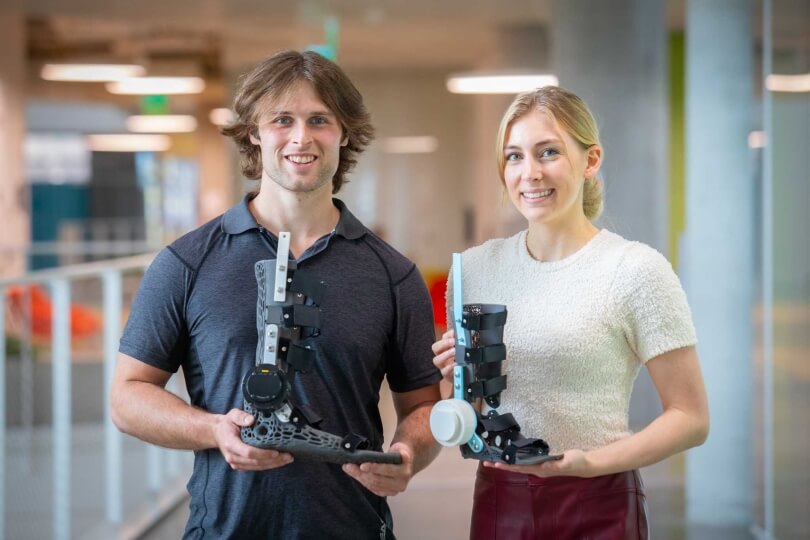News
For their senior capstone project, David Picard and Cooper Knarr built a motorized ankle exoskeleton for children with cerebral palsy (Eliza Grinnell/SEAS)
Engineering Design Projects (ES 100), the capstone course at the Harvard John A. Paulson School of Engineering and Applied Sciences (SEAS), challenges seniors to engineer a creative solution to a real-world problem.
A Novel Ankle Exoskeleton for Children With Cerebral Palsy
Cooper Knarr and David Picard, S.B. ‘25, Mechanical Engineering
Advisor: Patrick Slade
• Please give a brief summary of your project.
Cerebral Palsy (CP) is the most common cause of childhood disability in the United States, and is most commonly treated using a Thermoplastic Ankle-Foot-Orthosis (AFO) device. Such devices help prevent muscle deformity, but have notable limitations, such as causing muscle atrophy, reduced push-off power, and lacking customization. As a result, patients experience increased energy expenditure, increased hip compensations, and suboptimal functionality. Motivated by David’s 7-year-old godson with cerebral palsy, this thesis built a motorized CP-specific ankle exoskeleton which monitors gait phase in real time and provides personalized assistive torque at the ankle to help children engage in daily activities, such as sports and recess, without sacrificing the critical therapeutic benefits of their current AFOs. The device was designed to “grow” with the child, utilizing reusable parts to reduce cost and increase accessibility.
• How did you come up with this idea for your final project?
Recognizing both the challenges and potential of David’s godson inspired us to develop a device that gives kids the tools necessary to play at recess, join in sports, and just be a kid. The device was designed and built with all his needs in mind and in a way that gives him his critical CP therapeutic needs while aiming to increase walking speed while decreasing energy expenditure. This project explores a new direction by combining the familiarity and therapeutic value of AFOs with the adaptive assistance of a powered exoskeleton, a fusion that hasn’t been widely pursued in current research.
• What was the timeline of your project?
Last summer, David started researching possible ideas for a general device goal and design and idealized a rough CAD design and general device concept. Overall, this project has three separate sections: physical models, gait detection, and motor control. Last fall, we spent time developing three physical prototypes, aimed at refining and understanding which aspects of the exoskeleton are necessary to ensure proper walking biomechanics. At the same time, we were able to gather an initial understanding of how we might detect gait phase and determine the correct torque application magnitude and timing. Throughout the winter, we refined the gait detection and physical models, focused on simulating different scenarios and determining which materials we would like to incorporate in the final design. By February, we were focused on motor control, which meant bringing the physical model together with the gait detection. The last prototype was finished in March and the final device was completed for the final presentation on March 25th!
• What part of the project proved the most challenging?
Completing a project with so many different components was difficult. We had to manage our time in a way that allowed us to complete each aspect of the project and recognize when it was necessary to move on and maintain momentum. Working within a tight timeline required us to prioritize progress over perfection, always keeping the end goal in mind.
• What part of the project did you enjoy the most?
The most exciting part of the project occurred when we assembled the final design and watched as the motor actuated for the first time! This reflected the first time we achieved what we set out to do.
• What did you learn, or skills did you gain, through this project?
Throughout this project, we learned and applied a wide set of technical skills driven by needs of the design. We learned advanced CAD modeling to develop complex, adaptable components that meet both functional and biomechanical requirements. We also learned about different gait detection methods, which allowed us to write a custom algorithm that could integrate safety features to make the device both smart and reliable. Finally, we explored motor control and integration, learning how to synchronize hardware and software to deliver real time assistive torque. Through it all, we gained a deeper understanding of how to engineer a complex solution, breaking it into subsystems, iterating across disciplines, and bringing a full design to life.
Topics: Academics, Health / Medicine, Materials Science & Mechanical Engineering
Cutting-edge science delivered direct to your inbox.
Join the Harvard SEAS mailing list.
Press Contact
Matt Goisman | mgoisman@g.harvard.edu



